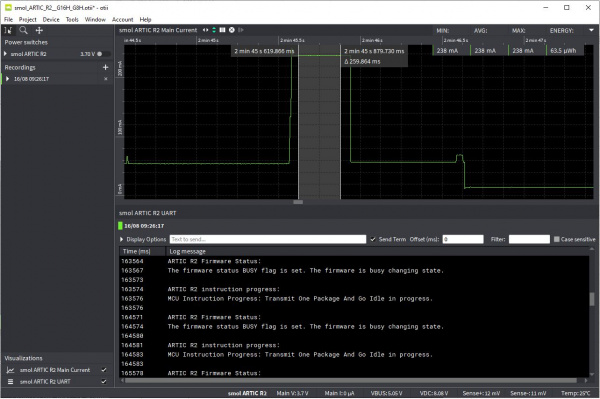smôl Hookup Guide
Current Draw
If you are using smôl to develop your own wildlife tracker, you will of course be very interested in how much current the board draws.
The fantastic Otii Arc Power Analyzer has allowed us to capture the exact peak transmit current draw of the smôl ARTIC R2 satellite transceiver and to study the average current drawn when the chip is idle. We've used this data to help optimize the code in this example to extend the battery life as much as possible when using the smôl ARTIC R2 with the smôl ESP32 Processor Board, smôl ZOE-M8Q GNSS Board and the smôl Power Board LiPo.
The picture below shows the current draw captured by Otii Arc for a complete transmit cycle using this example. The gain here is set to maximum.
At the start of the transmit cycle, the ESP32 Processor Board is woken up by the Power Board. It turns on the ZOE-M8Q GNSS board and waits for a fix. The current draw here is approximately 100mA for ~10 seconds.
Once the ESP32 has a location fix, it can calculate the time of the next ARGOS satellite pass. The power board woke the ESP32 up 1 minute before the start of the next pass, so the ESP32 goes in and out of light sleep for the next ~30 seconds.
The ARTIC R2 is powered on at the 40 second mark and the first of five transmits takes place just after the one minute mark.
The code example transmits five times on each satellite pass. The gap between the transmits is 90 seconds with a mandatory ±10% jitter. In between, you can see the ESP32 going in and out of light sleep with the ARTIC R2 being powered up 20-30 seconds before the next transmit is due.
The phenomenal data captured by Otii Arc allows us to zoom right in on the transmit itself and capture the true maximum current draw:
It's then child's play to extract the data we need!
- LiPo Battery Voltage: 3.7V
- Peak Current Draw ESP32 + ARTIC R2 (maximum gain): 238mA
- Peak Current Draw ESP32 + ARTIC R2 (minimum gain): 114mA
- Average Current Draw during a complete 5*TX transmit cycle (maximum gain): 29.9mA
- Average Current Draw during a complete 5*TX transmit cycle (minimum gain): 24.9mA
- Average continuous ESP32 + ZOE-M8Q GNSS Current Draw: 97mA
- Current Draw during deep sleep: 6.4µA
- Power Consumption during a complete 5*TX transmit cycle (maximum gain): 13.3mWh
- Power Consumption during a complete 5*TX transmit cycle (minimum gain): 11.1mWh
We can then use this data to predict the battery life based on the transmit power and the number of transmissions per day. The satellite pass-prediction code in our Arduino Library can calculate the timing of the satellite passes with the highest elevation each day to maximize the chance of the transmission being received. Transmitting five times per day at maximum power, we could expect our very modest 400mAh battery to last over 100 days!

